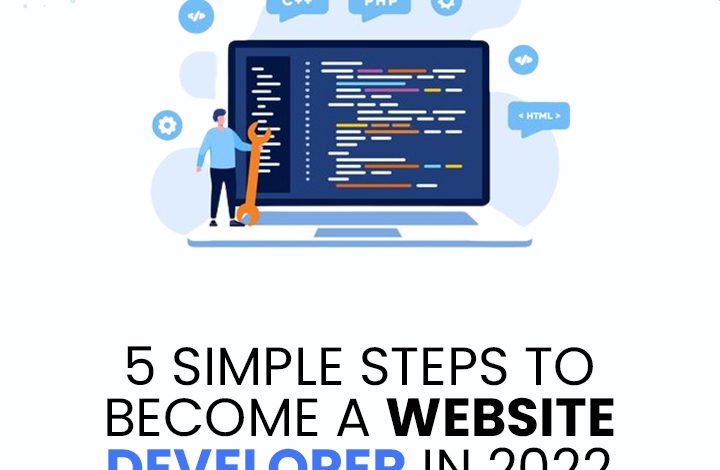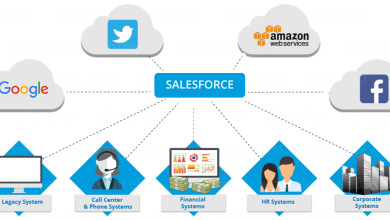6 Simple Steps to Become a website Developer in 2022

If you’re thinking of being a Website Developer, you’ve done a great job. The area of Web Development has experienced an impressive growth rate in the last few years, and it’s only going to continue to grow. It’s also a lucrative area, making it a more appealing career choice. What is the best way to start as the next Web Developer in 2022? In this short guide, you’ll discover the six steps you should follow to begin a career in web design.
1. Research the Field:
The first step is to learn more about the world of web development. You aren’t going to leap into an entirely new field without doing some research on the subject first, do you? The amount of study you conduct is entirely up to you. However, the more informed and well-prepared you are before beginning your new job, the better your success odds.
What is Web Development?:
Web development encompasses all involved in creating and maintaining the website. Web Developers employ a range of programming languages and tools to build websites that are appealing to the eye, easy to use, and free of errors. Can make websites to serve any purpose and range from a basic, single-page site to a complex social media or e-commerce website.
What’s the Difference Between Front End, Back End, and Full Stack Development?
Web development is generally divided into three distinct types: front-end, back-end, front-end, and full-stack. The most significant difference between the three kinds is the part of the site is being developed. Front-end web development is focused on the user-facing aspect of the website, everything the user can see and interact with. Back-end development is all that happens behind the scenes to support the front end, including databases, servers, and applications. Full-stack development mixes front-end and backend development with elements from each.
Essential Web Development Skills:
In a way, the skills you’ll require depend on whether you choose to concentrate your career in front-end, backend, or even full-stack design. There are, however, some fundamental capabilities that can apply to all Web Developers who are interested such as:
- Computer literacy
- Teamwork
- Attention to detail
- Problem-solving
If you look at the various specialities in Web development, the abilities needed vary. Anyone interested in becoming a Front-End Web developer must possess (or be able to acquire) the following abilities:
- A thorough understanding of HTML, CSS, and JavaScript
- Knowledge of the user experiences (UX) principles
- A desire to create websites that are stunning and efficient
- Ability to test code to identify problems, find bugs, and monitor changes to the code
- Familiarity with front-end tools like frameworks, libraries, as well as Content management systems (CMS)
Anyone thinking about a job as Back End Web Developer should possess or learn these abilities:
- The ability to write quality code with Python, Java, and PHP
Ability to build and manage web-based applications.
Experience with databases hosting environment, hosting and server management
Ability to study problems, identify solutions, and then make adjustments to the code
- A thorough understanding of security compliance and accessibility
2. Choose a Specialty:
After completing your research, it’s time to decide the area of expertise you’d like to focus on: front-end back end, front end, or full-stack development. It’s easy to think that programming is just coding. However, there are some important differences between these three types of web development. To succeed, you need to select the one that’s most in line with your interests and personality.
For example, the ideal area of expertise for visually-oriented and creative people is most likely front-end web development. If your style is more analytical and you love working through complex problems to develop solutions that work, you must focus on backend web development. A Full-Stack web developer can perform work in both the front end and back ends of a site, making it an ideal choice for anyone who is a multi-faceted expert.
Naturally, these are a general description of three different concentrations that you can conduct your investigation to determine which one is best for you. You could also try talking to people who are currently working in web development or enrolling in one or two online classes to determine which one is compatible with your strengths, interests, and goals for your career.
3. Learn the Fundamentals:
If you’ve decided which path to take, the next step is to pick an educational way. Are you looking to attend classes online or in-person? If you choose to study online, do you have the necessary discipline to stick with the self-guided courses, or would you rather enrol in a class taught by a live instructor, so you can ask questions and receive immediate feedback?
It is also important to consider the amount of time and money you’re willing to learn about web development. Are you looking to master the art in the shortest amount of time possible with an intensive boot camp, or would you prefer to take individual classes in a limited time frame? Do you require a school with flexible financing options? Do you have the funds to pay for coding courses?
Make sure you are aware of mentorship or job placement support; many schools will assist you in finding work following the completion of your education in web development and provide you with a professional to help you learn. Examine the many ways to know before choosing the one that best suits your requirements.
4. Develop Your Skills:
While you’ll be given numerous opportunities to build your abilities during a course but it’s vital to keep using the skills you’ve learned after learning the fundamental elements and terms used in web design. Start small-scale projects to build your abilities. Don’t jump in the water to try an intricate project if you’re unsure if you’re at the right level. Begin with your skills and build them by practising. At some point, you’ll be ready to tackle bigger and more complex tasks.
5. Create a Portfolio:
A well-constructed portfolio is the most effective tool you use when searching for a job in web development. Once you’ve grasped the fundamentals and had the opportunity to build your expertise put together all of your work to create an impressive portfolio. Be sure the portfolio displays a wide range of your work. You could also think about highlighting the method you employ in each portfolio component in the form of a case that will provide potential employers with an understanding of how your talents can benefit the company.
6. Search for Jobs:
When you’ve got your impressive portfolio to present to prospective employers, you’re ready to begin your job hunt and develop into an experienced Web Developer. There are many options for looking for a new position, but the best approach is to contact the college where you took your classes in web development. They’ll likely provide you with some great prospects.
Beyond that, you could also lookup web development jobs on websites such as Indeed, Glassdoor, ZipRecruiter, CareerBuilder, and LinkedIn. It’s an excellent idea to reach out to your family members, friends, or former co-workers and acquaintances to determine whether they have any potential job leads. Due to the huge demand for web-based development skills, you’ll be able to find a job in no time until you land your first job that pays.
Conclusion:
Are you ready to begin looking into your options for web development? SoftCircles, LLC, a web development company in New York, offers web development services in their office within New York City. They provide top-quality Web development solutions. Visit their website regularly for more information.





